
Fractures Page Menu: 1 2 3 4 5 6 7 8 9 10 11 12 Next>>
Fracture Treatment During the Golden Age of Piracy, Page 11
Preventing Accidents
The last step in healing a fracture during the golden age of piracy was to prevent 'accidents.' When we hear 'accident', our minds think of unexpected occurrences. While some of these things may have been unexpected, the period notion of an accident in this context is what we would call complications. As military surgeon Richard Wiseman explains, 'accidents' are those things, "which happening in Fractures retard their Cure"1. Sea surgeon John Atkins does strike a note of the unexpected in his explanation, calling these "extraordinary Accidents [which] may intervene ... and exacts our Attention before the Fracture"2.
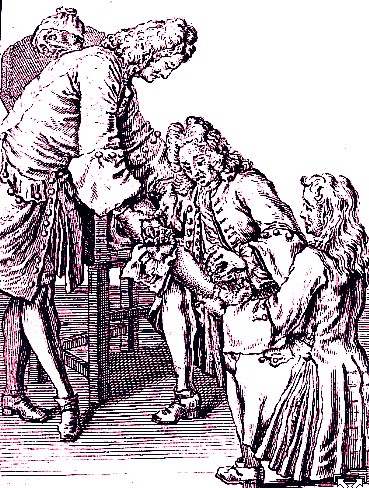
Watching for Complications, From Traite des Operations
de Chirurgie, by Rene Garengeot, p. 365 (1723)
Period surgeons suggest a variety of 'accidents' that can accompany a fracture. Richard Wiseman gives the most comprehensive list, including "Pain, Inflammation, Apostemation [formation of pus], Gangrene, Itching, Excoriation [formation of skin lesions], Callus more or less than should be, Weakness of the Member, and depraved Figure."3 It is interesting that Wiseman includes Apostemation in his list, given that many period surgeons believed the formation of pus was a sign that the bad humors were leaving the body. Some gave medicines to encourage this.
German surgeon Matthias Gottfried Purmann also considers several accidents including "great Swellings, Pain, Twitchings, Cramps, Heats, Inflammations, and, if not timely prevented, a Gangrene and Mortification"4.
Several of the other golden age of piracy era surgical authors also mention some of these symptoms, even if they don't provide them in sequential form. We are going to take a look at four of the most frequently discussed 'accidents' and how period surgeons handled them. These include pain, swelling/inflammation, itching and preventing gangrene.
1 Richard Wiseman, Of Wounds, Severall Chirurgicall Treatises, p. 471; 2 John Atkins, The Navy Surgeon, p. 50; 3 Wiseman, ibid.; 4 Matthias Gottfried Purmann, Churgia Curiosa, p. 212
Preventing Accidents: Pain
"Pain, every one knows, will unavoidably accompany a Fracture, and to no small Degree affect the Patient though it [the fracture] be well reduced; ...the Appearance of Ease, when the Limb is reclined on a soft Bed, and at Rest, may deceive us into a contrary Belief; for it is only with moving that it becomes most sensibly affected; and this it will be, whether it be well or ill reduced." (John Atkins, The Navy Surgeon, p. 42)
Pain during fracture healing is one of the most straightforward problems that the period
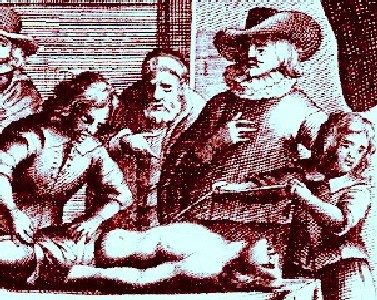
A Patient in Pain, From L'Arcenal de
Chirurgerie by Johannes Scultetus, Frontispiece (1672)
surgeons discuss. As Atkins explains in the above quote, a certain amount of pain was to be expected. He goes on to recommend that pain is "never to be considered or attended to, as a dangerous Symptom, till it becomes more than ordinarily acute; and then... it is worthy of our exactest Industry to search the Causes, and prevent or correct them."1
Most of the solutions offered by surgeons at this time are simple and direct. Atkins notes that pain my result from "too hard Bandage, too hard Lodging [the place where the fracture is resting is uncomfortable and aggrevates the wound] ill Reduction or Position [the bone was not properly set by the surgeon], or finally, a bad Habit of Body [the patient's diet and/or physical fitness is not conducive to healing]"2.
Similarly, John Woodall states that if the patient "complaine much of the paine, search the cause, namely, see that the ends of the bones lie right, and that the splints gall him not, also that there be no wrinckles in the clouts applied, and that it bee not too hard or too soft bound, all these things duely considered."3
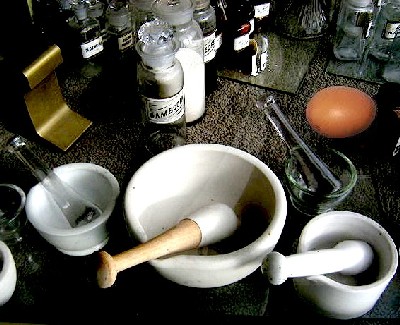
Apothecary Tools and Medicines
Atkins considers another cause of pain, explaining that if "a Discracy [dyscracy - disharmony of the humors] and ill Disposition be the Cause, we should endeavour to amend it with a Course of gentle Catharticks [purging medicines] and Alteratives [medicines that return a patient to normal health]"4.
Atkins' reasoning here is "Pain and Fever constantly follow one another, like Cause and Effect; and by removing one, we seldom fail to subdue the other"5. He prescribes the above medicines to prevent the fever he is expecting. His reasoning for this outcome is somewhat fascinating. Pain "lessens the Secretions [of the 'good' humors required for healing]; or, which is the same Thing, acting as a Stimulus, divides the Blood into smaller Parts; either of which increases its Quantity, which is the immenent Cause of a Fever."6
1 John Atkins, The Navy Surgeon, p. 44-5; 2 Atkins, p. 45; 3 John Woodall, the surgions mate, p. 162; 2; 4,5 Atkins, p. 45; 6 Atkins, p. 44
Preventing Accidents: Swelling and Inflammation
Hippocrates has the most to say about what to do for swelling of a fractured member. He suggests the swollen part "should be well wrapped in unscoured and carded wool, washed with wine and oil, and anointed with cerate [wax mixed with oil, lard and vegetable material of a viscous consistency] , before bandaging."1 Matthias Gottfried Purmann suggests that the reader apply "a Defensive Plaister, to prevent a Defluxion of Humours, which may Cause and Inflammation or a Swelling" above and below the bandage.2
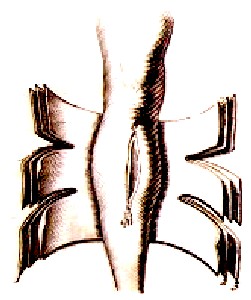
A Fracture With Wound and Swelling,
From Alle De Medinale
en Chirurgicale,
by Solingen Cornelius
(1698)
Hippocrates suggests a simple mechanical cure for swelling. The surgeon "may sooner reduce the swelling by laying aside the splints, and applying plenty of bandages to them, beginning from below and rolling upward; for thus the swellings will be most speedily reduced, and the humors [will] be propelled to the parts of the former bandages."3
Hippocrates says that the level swelling is an indicator of healing in a fracture. The surgeon should find the member "at every dressing always more and more free of swelling, and the swelling should have subsided on the whole part comprehended by the bandages."4 He felt keeping swelling under control in compound fractures was important because it allowed faster suppuration (formation of pus) as well as more rapid cicatrization (healing over with a scar).
For inflammation, sea surgeon John Woodall prescribed alum mixed with vinegar because it "swageth paine, tempereth well the parts, and yet repelleth and discusseth the bloud gathered, and ,,,it fortifieth mightily the member, by sticking close and hard to it, I have used it long without repentance"5.
1 Hippocrates, Hiipocratic Writings, Translated and Edited by Francis Adams, p. 83; 2 Matthias Gottfried Purmann, Churgia Curiosa, p. 213; 3 Hippocrates, p. 83; 4 Hippocrates, p. 84; 5 John Woodall, the surgions mate, p. 164
Preventing Accidents: Itching
Itching in fracture healing is one of the most widely discussed accidents during the golden age of piracy. French surgeon Ambroise Paré explains that itching "ariseth from a collection and suppression of subacride vapours, arising from the blood, and other humors under the skin. Whence a light biting, which causeth a simple itch, or else a more grievous and acride one, from whence (in Galens opinion) proceeds a painefull itching. Wherefore such matter, as the cause, being evacuated, all itching ceaseth."1
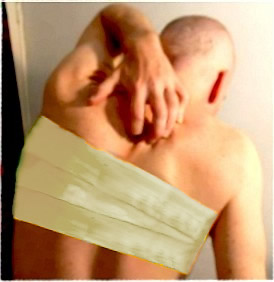
Although we tend to dismiss humors as a cause of illness today, Paré's explanation has some merit. Modern practice suggests several potential causes of itching in healing. The primary one is that because the wound is always covered (with dressings, or today with a cast) the skin cannot shed dead skin, which makes it itch. Another cause of itching is healing itself. Other, usually less common, causes of itchiness include dried blood on the skin and over tight bandaging.2
Golden age of piracy period surgeons actually recognized many of these problems. We have already talked about their concern about over-tight bandaging. Some recognized that having the part constantly covered led to itching.
Paré explains that a cause of itching is that "the pores of the part are shut up, and as it were oppressed with the burden of the emplaisters, boulsters [pads], and ligatures [ties and cloth tapes], which are put about the part."3 Richard Wiseman likewise notes that itching occurs "through the detention of Humours, which are made sharp by Deligation [bandaging], (Perspiration being thereby hindred.) and that it wont to terminate in a most painful Excoriation and inflamed Redness."4 He elsewhere suggests that itching can be caused "by the heat of the Weather, and want of Transpiration [sweating]."5
Paré and Wiseman's solutions are similar. Paré advises the surgeon to "loose the ligatures everie third day, that, as by loosing their tyes, their sanious [serum/pus] and fuliginious [sooty, probably referring to dead skin cells] excrements, shut up under the skinne, may freely passé forth"6. Wiseman likewise orders the bandages to be removed when the part starts to itch.7
Once the dressings are removed from the itchy part, the consensus was to foment the part with some kind of liquid. This and the rubbing motion used to wash the part would help cleanse the dead skin away.
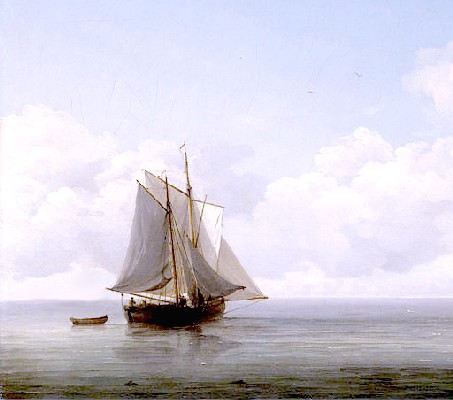
Artist: Charles Brookings (mid 18th century)
Fortunately, Sea Water For Bathing Fractures Was Easy to Come By
Paré says "the part must bee long fomented with hot water alone, or else with a decoction of sage, chamomile, roses, and melilote [sweet clover] made in wine and water: for long fomenting attenuates [reduces] and evacuates, but shorter fills and mollifies, as it is delivered by Hippocrates."8 Wiseman suggests bathing the itching member both with water9 and sea-water10, "which will give a breathing to it by the Pores"11.
Paré gives the most obvious solution to the problem. He recommends "gentle frictions, performed with your hand, or a warme linnen cloath upwards, to the right side and left, and circularly to everie side, are good."12 (If you have an itch, scratch it.)
Once bathed and possibly itched, the part is to be redressed. In one case study, Wiseman "drest him [his patient] up with emplast. de lithargyro. [a lead-based medicated plaster, which serves as an astringent]."13
John Woodall skips the bathing step and resorts to simply using Unguentum Triapharmacon for itching as he did for irritation caused by rubbing splints. He notes that it will cure the problem in one dose.14
1 Ambroise Paré, The Apologie and Treatise of Ambroise Paré, p. 171; 2 Itching: Why Does It Itch So Much?, mybrokenleg.com, gathered 5/15/14; 3 Paré, p. 171; 4 Richard Wiseman, Of Wounds, Severall Chirurgicall Treatises, p. 464; 5 Wiseman, p. 427; 6 Paré, ibid.; 7 Wiseman, p. 427 & 464; 8 Paré, ibid.; 9 Wiseman, p. 464 & 471; 10 Wiseman, p. 427 & 471; 11 Wiseman, p. 471; 12 Paré, p. 171; 13 Wiseman, p. 427; 14 John Woodall, the surgions mate, p. 167
Preventing Accidents: Gangrene
Gangrene is complex and deserves a topic unto itself. (In this case, literally.)
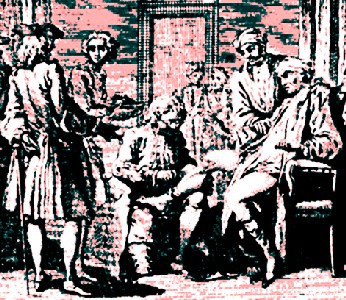
Preventing Gangrene, From County Infirmary, Northampton
by Richard Grey via Wellcome Images (1744)
However, a few of the period surgeons do discuss ways to prevent gangrene when treating a fracture.
John Woodall warns that "fractures are much incident unto [gangrene], by reason of great store of contused bloud gathered [at the site of the fracture], that can hardly be discussed [naturally removed by the body] on the instant, which thereby causeth obstructions, whereupon followeth inflammation and paine, and consequently a Gangrene"1. Matthias Gottfried Purmann pinpoints several other potential causes of gangrene which will sound familiar, including "too hard binding up the part, uneasy Lying, and the Applications of hot Plaisters and other Medicines."2
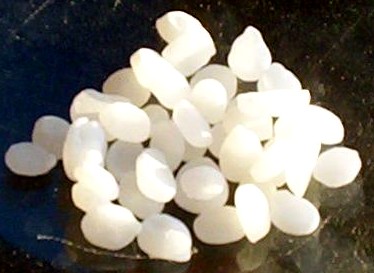
Photo: Wiki User Walkerama
Lixivium (Sodium Hydroxide)
To prevent gangrene in a fractured wound, Woodall prescribes medicines including "minerall or sea-salt, wet the clowt [clout - piece of cloth]... therein, and wring it out hard, and apply it to smoothe, close and hot about the member binding it so up"3. If gangrene is feared in a fracture, Richard Wiseman tells to the surgeon to "slacken your Bandage, and foment the Part with a Lixivium [alkaline salts from wood ash] in which have been boiled scordium [water germander] absinth. [a wormwood tonic] centaur. [centaurium erythraea] and the like. You may also apply over all a Cataplasm of Barley-meal, Lupines [lupinus], with the addition of such Ingredients as have been prescribed in the Chapter on Gangræna."4
1 John Woodall, the surgions mate, p. 164; 2 Matthias Gottfried Purmann, Churgia Curiosa, p. 212-3; 3 Woodall,p. 163; 4 Richard Wiseman, Of Wounds, Severall Chirurgicall Treatises, p. 471

